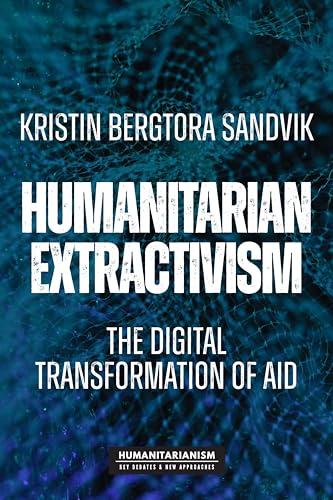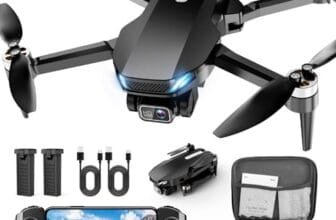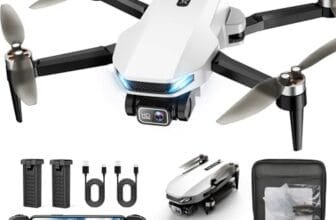
Drones play a crucial role in delivering humanitarian aid efficiently. They offer innovative solutions in challenging environments.
Humanitarian aid faces numerous challenges, especially in remote or conflict-ridden areas. Drones emerge as a vital tool in these situations. They can reach places traditional methods cannot, making them indispensable. Books like “Humanitarian Extractivism” and “The Good Drone” delve into the ethical and technological aspects of drone use in aid.
These resources explore the balance between innovation and ethical considerations. The “Routledge Handbook of Security Studies” provides insights into the security implications of drone technology. Meanwhile, “The Routledge Companion to Media and Humanitarian Action” examines the media’s role in shaping perceptions. “Masculinities at the Margins” broadens understanding by exploring non-traditional roles in military contexts. Together, these works offer a comprehensive look at drones in humanitarian aid.
Humanitarian Extractivism: The Digital Transformation Of Aid

The book, “Humanitarian extractivism: The digital transformation of aid,” is ideal for those who are deeply interested in understanding the evolving landscape of humanitarianism. This includes academic researchers, policy makers, and students of international relations who are keen to explore the intersection of technology and humanitarian aid. Additionally, professionals engaged in non-governmental organizations (NGOs) and aid agencies can gain valuable insights into the digital transformation processes that are reshaping the sector.
Pros:
- Offers a comprehensive analysis of humanitarianism’s digital evolution.
- Written by experts in the field, ensuring credible and insightful content.
- Published by the reputable Manchester University Press.
- Compact dimensions make it easy to carry and read on the go.
Cons:
- The academic tone might be challenging for casual readers.
- Limited to 168 pages, potentially restricting the depth of exploration.
This book dives deep into the features of digital transformation within the humanitarian sector. It explores how technologies like big data, artificial intelligence, and blockchain are being integrated to optimize aid delivery and improve accountability. These features highlight the benefits of increased efficiency and transparency in humanitarian efforts, allowing aid organizations to better track resources and manage logistics.
Furthermore, the text examines the ethical considerations surrounding these technological advancements. Readers will gain insights into the potential risks and challenges that arise from digital extractivism, such as data privacy concerns and the digital divide. The book aims to equip its audience with a balanced perspective on how technology can be harnessed for humanitarian good while being mindful of its implications.
To buy this product, click here.
The Good Drone

The ideal customer for “The Good Drone (Emerging Technologies, Ethics and International Affairs)” is someone deeply interested in the intersection of technology and ethics within the realm of international affairs. This book is particularly suited for academics, policy makers, and technology enthusiasts who wish to explore the ethical implications of drone technologies and their impact on global dynamics.
Pros:
- Offers a comprehensive analysis of emerging technologies.
- Provides insights into ethical considerations surrounding drone usage.
- Serves as a valuable resource for policy development.
- Written by a reputable manufacturer: Routledge.
- Available in its first edition.
Cons:
- May be too academic for casual readers.
- Limited to 212 pages, which might not cover all aspects in depth.
- Published in 2016, some content may not reflect the latest developments.
“The Good Drone” delves into the features of drone technology, emphasizing the importance of understanding its role in international affairs. Readers will benefit from an in-depth exploration of how drones can be used for both positive and negative outcomes, challenging the conventional perspectives on their utilization. With a focus on ethical implications, the book encourages readers to consider the broader impact of drones on society and global security.
The book’s first edition ensures readers receive a fresh perspective on these topics, compiled by experts in the field. The publication date of 2016 means it captures the thoughts and theories prevalent at the time, serving as a crucial historical document for understanding the evolution of drone ethics. Despite being slightly dated, its core insights remain relevant, offering a foundational understanding for those engaged in policy making or technology development.
To buy this product, click here.
Routledge Handbook Of Security Studies

The Routledge Handbook of Security Studies is an invaluable resource for students, researchers, and professionals in the field of security studies. This comprehensive handbook is ideal for those looking to deepen their understanding of contemporary security issues, theories, and practices. Whether you are an academic preparing for a course, a professional seeking to enhance your knowledge, or a student striving to excel in your studies, this book provides the insights you need.
Pros:
- Comprehensive coverage of diverse security topics
- Written by renowned experts in the field
- Updated edition with recent developments
- Offers critical analysis and perspectives
Cons:
- Dense material may be challenging for beginners
- Requires prior knowledge of security studies
The Routledge Handbook of Security Studies features an impressive collection of essays and analyses written by leading scholars in the field. Each chapter provides a thorough examination of key security concepts, offering readers a rich tapestry of insights and perspectives. This handbook is structured to guide readers through complex theories and real-world applications, making it a crucial addition to any security studies curriculum.
One of the standout features of this handbook is its ability to cover a wide range of topics while maintaining depth and rigor. The second edition ensures that readers have access to the most current information, reflecting recent developments in the field. From traditional security challenges to emerging threats, this book prepares readers to engage with a dynamic and evolving landscape. The critical approach encourages readers to question established norms and consider alternative viewpoints, fostering a deeper understanding of global security issues.
To buy this product, click here.
The Routledge Companion To Media And Humanitarian Action

The ideal customer for The Routledge Companion to Media and Humanitarian Action is anyone interested in the intersection between media and humanitarian efforts. This book is particularly beneficial for academics, researchers, and students in the fields of media studies, cultural studies, and international relations. Additionally, professionals working in non-governmental organizations (NGOs), policy-making, or communications who aim to understand the role of media in humanitarian action will find this resource invaluable.
Pros:
- Comprehensive coverage of media and humanitarian action topics.
- Contributions from leading experts in the field.
- Interdisciplinary approach enhances understanding across different fields.
- Current and relevant insights into media’s role in humanitarian efforts.
Cons:
- Dense material may be challenging for those new to the subject.
- High price point may be a barrier for some potential readers.
The Routledge Companion to Media and Humanitarian Action stands out due to its comprehensive coverage of how media influences humanitarian efforts. The book delves into various case studies and theoretical frameworks that provide readers with a profound understanding of the complex relationship between media and humanitarianism. This allows professionals in the field to leverage media effectively in promoting humanitarian causes and strategies.
One of the significant benefits of this companion is its interdisciplinary nature, which draws insights from multiple fields such as communication studies, sociology, and political science. This broadens the perspective for readers, enabling them to approach humanitarian action with a more holistic view. Moreover, by featuring contributions from renowned experts, the book ensures that readers are exposed to cutting-edge research and practical insights.
To buy this product, click here.
Masculinities At The Margins: Beyond The Hegemonic In The Study Of Militaries, Masculinities And War

For those deeply interested in the study of militaries, masculinities, and war, “Masculinities at the Margins: Beyond the Hegemonic in the Study of Militaries, Masculinities and War” presents an invaluable resource. This book is ideal for scholars, students, and researchers who aim to explore non-hegemonic masculinities within military contexts, providing a nuanced understanding that extends beyond traditional narratives.
Pros:
- Offers a unique perspective on masculinities within military settings.
- Published by Routledge, ensuring a high level of academic credibility.
- Concise with 127 pages, making it accessible for readers with limited time.
Cons:
- May not cover mainstream perspectives extensively.
- Limited to a specific audience interested in niche studies.
This book delves into the complexities of masculine identities within the context of militaries and warfare, challenging the hegemonic narratives that have dominated the field. By focusing on marginalized masculinities, readers gain insight into the diverse experiences and roles that men occupy, offering a broader understanding of masculinity that can be applied to current societal dynamics.
The features of this publication include a detailed analysis of the ways in which non-hegemonic masculinities manifest and are perceived within military environments. The benefits for users are clear: an enriched perspective that contributes to critical thinking and further research opportunities. Its publication date in 2020 ensures that the discussions are current and relevant, reflecting contemporary debates and theories in the field.
To buy this product, click here.
Frequently Asked Questions
What Are Key Benefits Of Drones In Humanitarian Aid?
Drones offer rapid response and real-time data collection in crisis zones. They deliver supplies and assess damage efficiently. Their ability to access hard-to-reach areas makes them invaluable in emergency situations. Drones also reduce human risk and operational costs, enhancing the effectiveness of humanitarian efforts.
How Do Drones Transform Digital Humanitarian Aid?
Drones provide accurate mapping and surveillance data, enhancing digital humanitarian efforts. They allow for better resource allocation and planning in disaster-stricken areas. By integrating with digital platforms, drones streamline communication and coordination among aid agencies, improving response times and overall efficiency in humanitarian missions.
What Ethical Concerns Surround The Use Of Drones?
Drones raise privacy and surveillance concerns in humanitarian contexts. There’s potential for misuse and unintended harm. Ethical considerations include maintaining transparency, ensuring community consent, and balancing efficiency with respect for local privacy and sovereignty. Addressing these concerns is crucial for ethical drone deployment in humanitarian aid.
How Do Drones Impact International Security Studies?
Drones influence global security dynamics by altering military and humanitarian strategies. They offer new tools for surveillance and intervention, affecting international relations. In security studies, drones are examined for their role in modern warfare and humanitarian missions, highlighting their dual-use nature and implications for global peacekeeping efforts.
What Role Do Drones Play In Media Coverage?
Drones provide unique aerial perspectives, enhancing media coverage of humanitarian crises. They capture footage from inaccessible areas, offering comprehensive visual storytelling. This aids in raising awareness and mobilizing support for affected regions. Drones thus play a critical role in shaping public perception and media narratives in humanitarian contexts.
Conclusion
Drones play a vital role in humanitarian aid efforts. They help deliver supplies quickly and safely. They reach areas that are difficult for humans to access. This technology is transforming how aid is distributed globally. Books like “humanitarian extractivism” and “the good drone” explore these changes.
They highlight the ethical implications and technological advancements. The “routledge handbook of security studies” provides insights into security concerns. Meanwhile, “the routledge companion to media and humanitarian action” examines media’s role in these efforts. “masculinities at the margins” discusses the impact of gender in military and aid contexts.
Understanding these aspects can guide better use of drones in crisis situations. By learning from these resources, we can improve humanitarian actions. Drones are not just tools; they are part of a larger system of aid. Their role in saving lives and delivering help is crucial.
This makes them an indispensable asset in modern humanitarian missions.












[…] managers seek effective ways to monitor and maintain their assets. Drones provide a unique perspective. They capture high-quality images and videos, revealing details that […]